Risk Management & Project Lifecycle: Sunderland University Project
VerifiedAdded on 2022/11/09
|11
|2051
|280
Project
AI Summary
This project submission delves into the critical aspects of risk management within construction projects, aligning with the PROM01 Master's Project requirements at the University of Sunderland. It encompasses a detailed exploration of project management principles, the project lifecycle, and the significance of risk management in achieving project objectives. The study covers risk identification, assessment, response strategies, and monitoring processes, emphasizing their importance in mitigating potential threats and enhancing project outcomes. Furthermore, it addresses the benefits and limitations of risk management, providing a comprehensive overview of its application in the construction industry. This document serves as a valuable resource for students seeking to understand and apply risk management concepts in project settings, with Desklib offering additional study tools and resources.
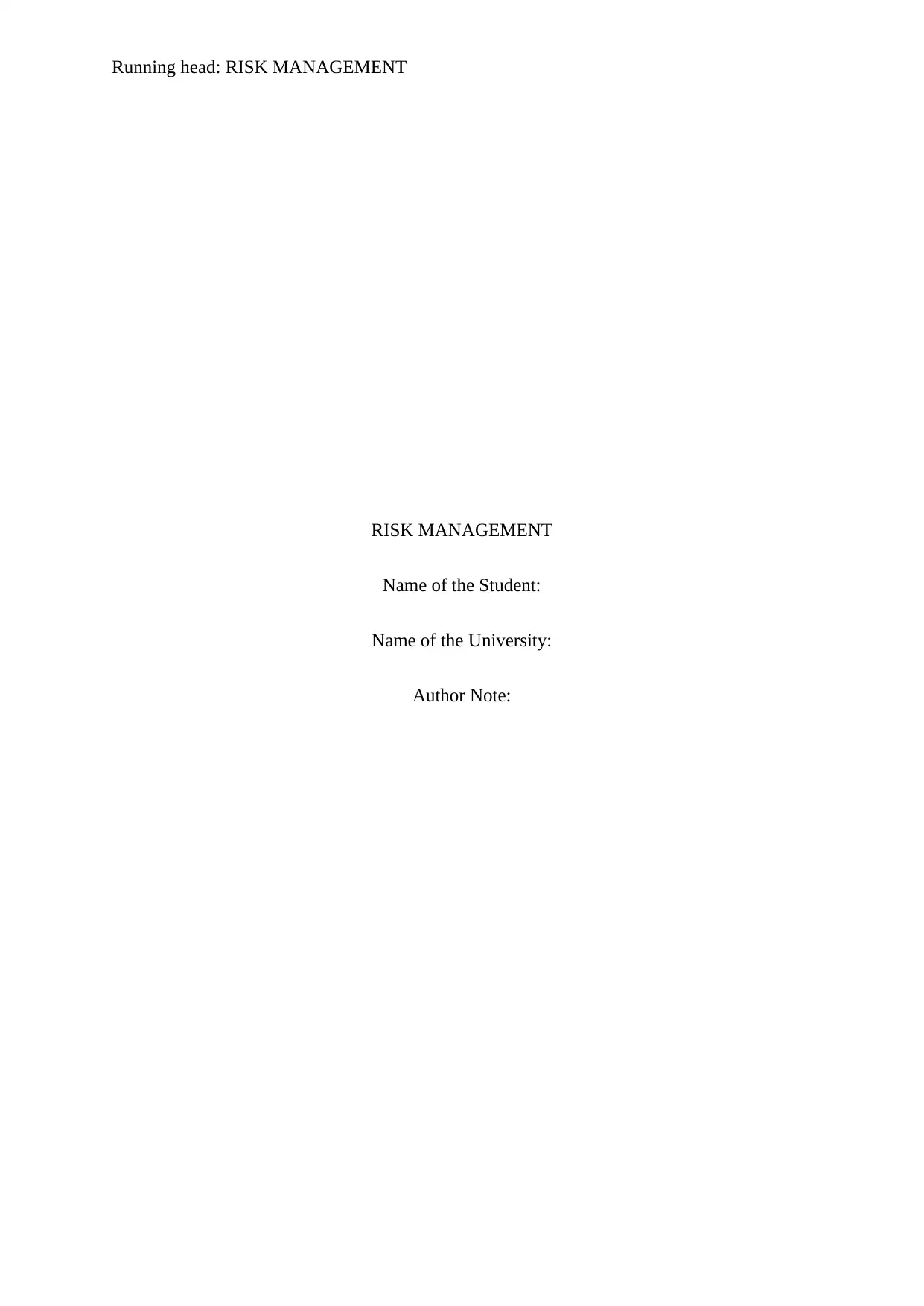
Running head: RISK MANAGEMENT
RISK MANAGEMENT
Name of the Student:
Name of the University:
Author Note:
RISK MANAGEMENT
Name of the Student:
Name of the University:
Author Note:
Paraphrase This Document
Need a fresh take? Get an instant paraphrase of this document with our AI Paraphraser
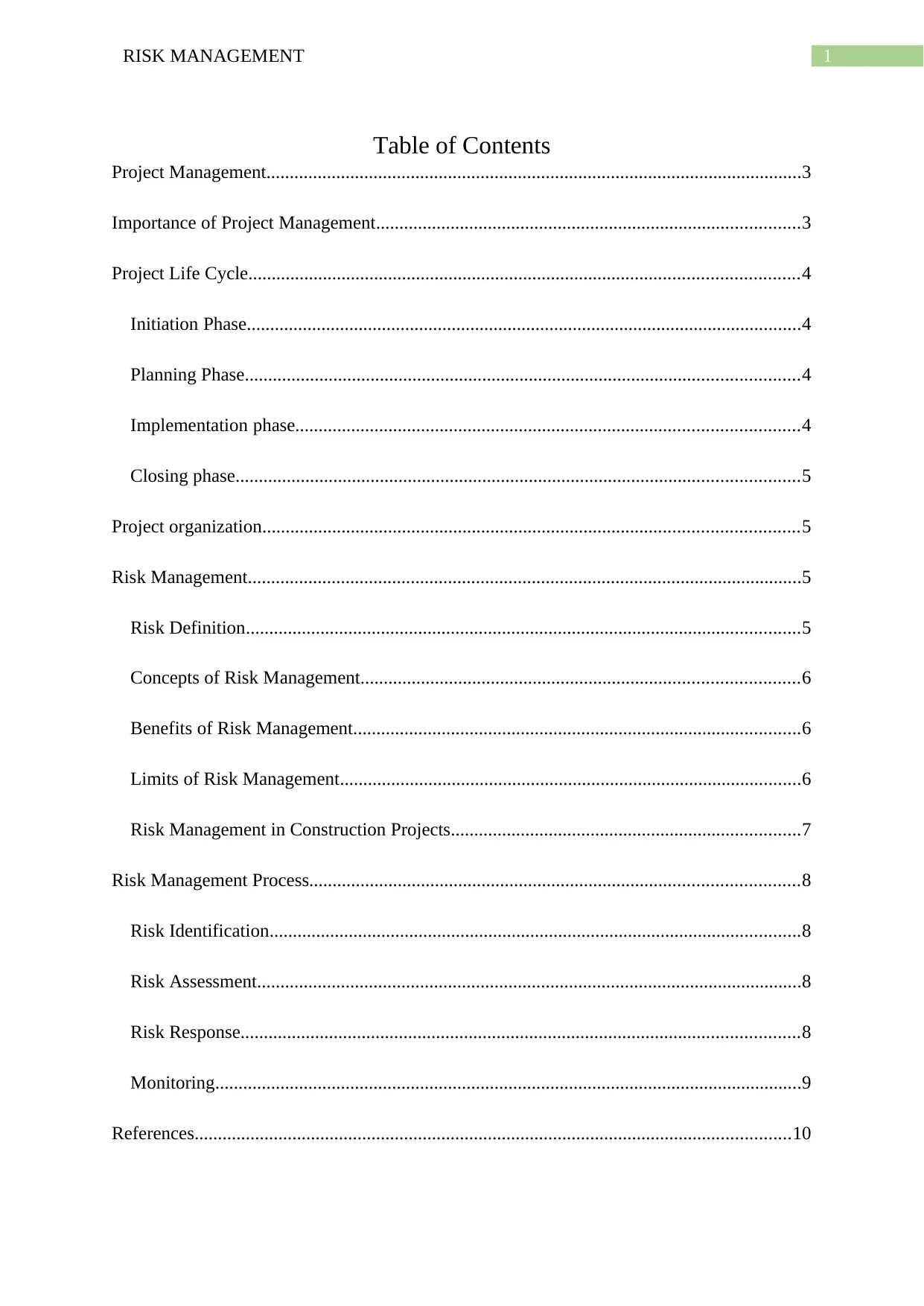
1RISK MANAGEMENT
Table of Contents
Project Management...................................................................................................................3
Importance of Project Management...........................................................................................3
Project Life Cycle......................................................................................................................4
Initiation Phase.......................................................................................................................4
Planning Phase.......................................................................................................................4
Implementation phase............................................................................................................4
Closing phase.........................................................................................................................5
Project organization...................................................................................................................5
Risk Management.......................................................................................................................5
Risk Definition.......................................................................................................................5
Concepts of Risk Management..............................................................................................6
Benefits of Risk Management................................................................................................6
Limits of Risk Management...................................................................................................6
Risk Management in Construction Projects...........................................................................7
Risk Management Process.........................................................................................................8
Risk Identification..................................................................................................................8
Risk Assessment.....................................................................................................................8
Risk Response........................................................................................................................8
Monitoring..............................................................................................................................9
References................................................................................................................................10
Table of Contents
Project Management...................................................................................................................3
Importance of Project Management...........................................................................................3
Project Life Cycle......................................................................................................................4
Initiation Phase.......................................................................................................................4
Planning Phase.......................................................................................................................4
Implementation phase............................................................................................................4
Closing phase.........................................................................................................................5
Project organization...................................................................................................................5
Risk Management.......................................................................................................................5
Risk Definition.......................................................................................................................5
Concepts of Risk Management..............................................................................................6
Benefits of Risk Management................................................................................................6
Limits of Risk Management...................................................................................................6
Risk Management in Construction Projects...........................................................................7
Risk Management Process.........................................................................................................8
Risk Identification..................................................................................................................8
Risk Assessment.....................................................................................................................8
Risk Response........................................................................................................................8
Monitoring..............................................................................................................................9
References................................................................................................................................10
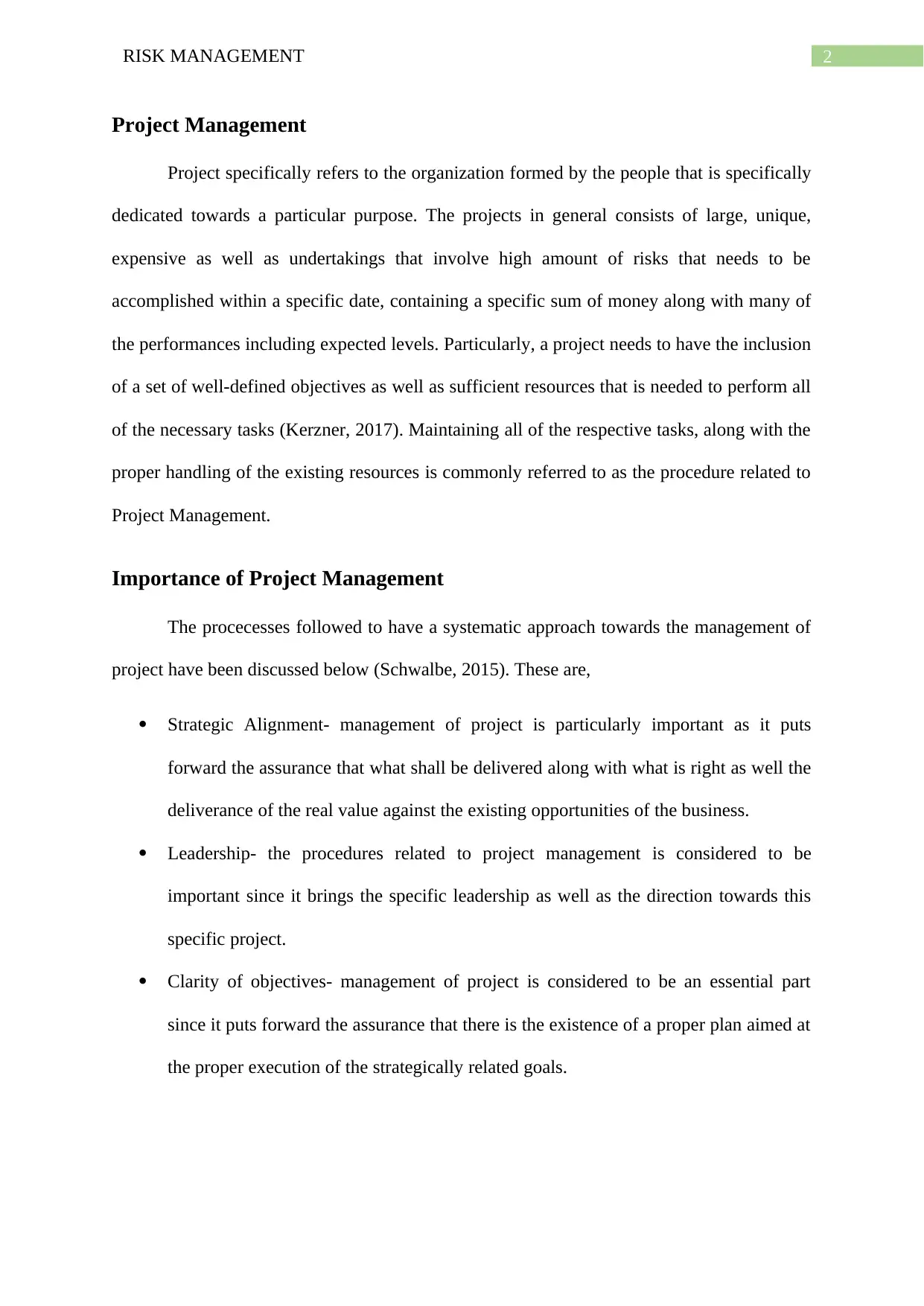
2RISK MANAGEMENT
Project Management
Project specifically refers to the organization formed by the people that is specifically
dedicated towards a particular purpose. The projects in general consists of large, unique,
expensive as well as undertakings that involve high amount of risks that needs to be
accomplished within a specific date, containing a specific sum of money along with many of
the performances including expected levels. Particularly, a project needs to have the inclusion
of a set of well-defined objectives as well as sufficient resources that is needed to perform all
of the necessary tasks (Kerzner, 2017). Maintaining all of the respective tasks, along with the
proper handling of the existing resources is commonly referred to as the procedure related to
Project Management.
Importance of Project Management
The procecesses followed to have a systematic approach towards the management of
project have been discussed below (Schwalbe, 2015). These are,
Strategic Alignment- management of project is particularly important as it puts
forward the assurance that what shall be delivered along with what is right as well the
deliverance of the real value against the existing opportunities of the business.
Leadership- the procedures related to project management is considered to be
important since it brings the specific leadership as well as the direction towards this
specific project.
Clarity of objectives- management of project is considered to be an essential part
since it puts forward the assurance that there is the existence of a proper plan aimed at
the proper execution of the strategically related goals.
Project Management
Project specifically refers to the organization formed by the people that is specifically
dedicated towards a particular purpose. The projects in general consists of large, unique,
expensive as well as undertakings that involve high amount of risks that needs to be
accomplished within a specific date, containing a specific sum of money along with many of
the performances including expected levels. Particularly, a project needs to have the inclusion
of a set of well-defined objectives as well as sufficient resources that is needed to perform all
of the necessary tasks (Kerzner, 2017). Maintaining all of the respective tasks, along with the
proper handling of the existing resources is commonly referred to as the procedure related to
Project Management.
Importance of Project Management
The procecesses followed to have a systematic approach towards the management of
project have been discussed below (Schwalbe, 2015). These are,
Strategic Alignment- management of project is particularly important as it puts
forward the assurance that what shall be delivered along with what is right as well the
deliverance of the real value against the existing opportunities of the business.
Leadership- the procedures related to project management is considered to be
important since it brings the specific leadership as well as the direction towards this
specific project.
Clarity of objectives- management of project is considered to be an essential part
since it puts forward the assurance that there is the existence of a proper plan aimed at
the proper execution of the strategically related goals.
⊘ This is a preview!⊘
Do you want full access?
Subscribe today to unlock all pages.

Trusted by 1+ million students worldwide
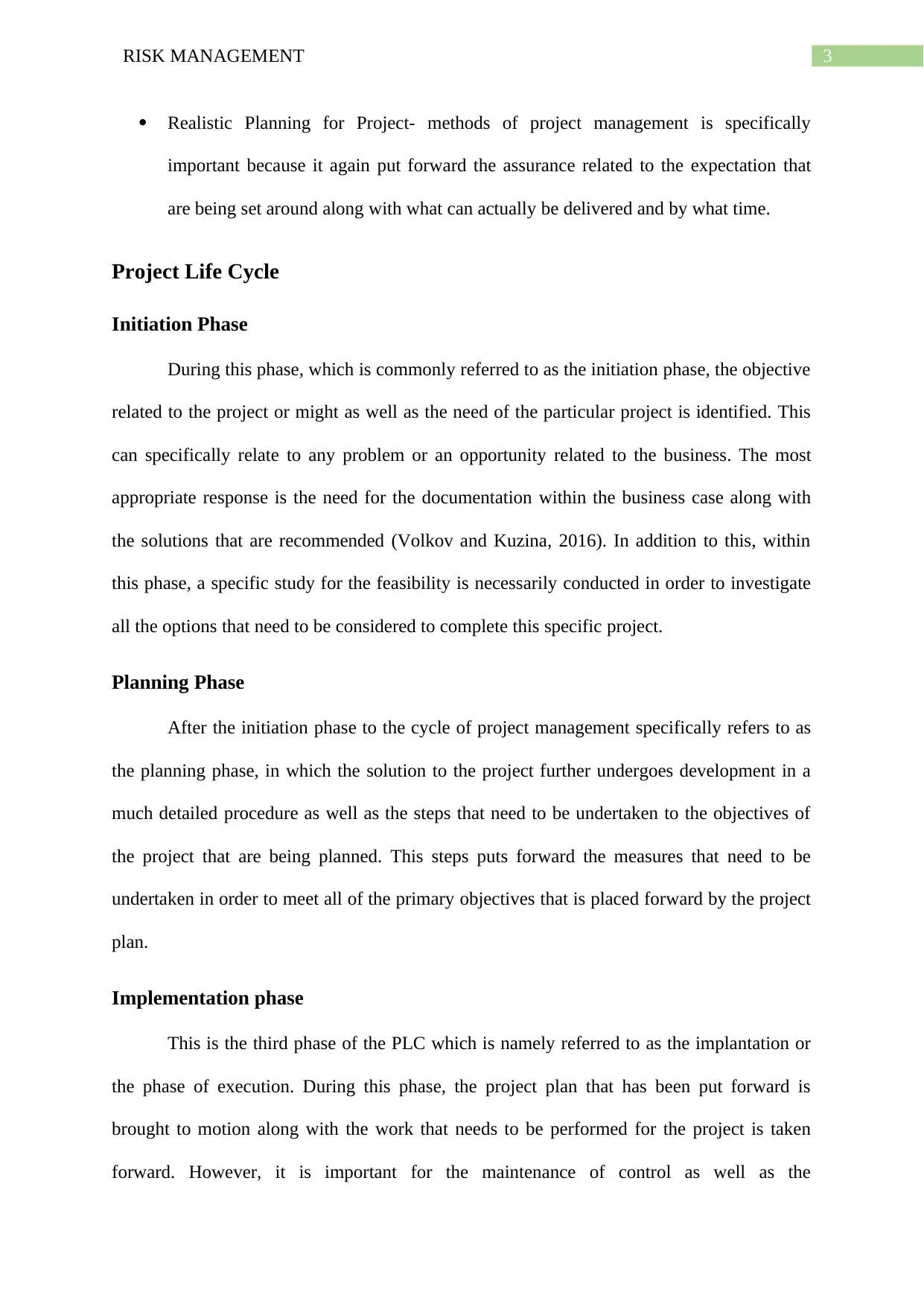
3RISK MANAGEMENT
Realistic Planning for Project- methods of project management is specifically
important because it again put forward the assurance related to the expectation that
are being set around along with what can actually be delivered and by what time.
Project Life Cycle
Initiation Phase
During this phase, which is commonly referred to as the initiation phase, the objective
related to the project or might as well as the need of the particular project is identified. This
can specifically relate to any problem or an opportunity related to the business. The most
appropriate response is the need for the documentation within the business case along with
the solutions that are recommended (Volkov and Kuzina, 2016). In addition to this, within
this phase, a specific study for the feasibility is necessarily conducted in order to investigate
all the options that need to be considered to complete this specific project.
Planning Phase
After the initiation phase to the cycle of project management specifically refers to as
the planning phase, in which the solution to the project further undergoes development in a
much detailed procedure as well as the steps that need to be undertaken to the objectives of
the project that are being planned. This steps puts forward the measures that need to be
undertaken in order to meet all of the primary objectives that is placed forward by the project
plan.
Implementation phase
This is the third phase of the PLC which is namely referred to as the implantation or
the phase of execution. During this phase, the project plan that has been put forward is
brought to motion along with the work that needs to be performed for the project is taken
forward. However, it is important for the maintenance of control as well as the
Realistic Planning for Project- methods of project management is specifically
important because it again put forward the assurance related to the expectation that
are being set around along with what can actually be delivered and by what time.
Project Life Cycle
Initiation Phase
During this phase, which is commonly referred to as the initiation phase, the objective
related to the project or might as well as the need of the particular project is identified. This
can specifically relate to any problem or an opportunity related to the business. The most
appropriate response is the need for the documentation within the business case along with
the solutions that are recommended (Volkov and Kuzina, 2016). In addition to this, within
this phase, a specific study for the feasibility is necessarily conducted in order to investigate
all the options that need to be considered to complete this specific project.
Planning Phase
After the initiation phase to the cycle of project management specifically refers to as
the planning phase, in which the solution to the project further undergoes development in a
much detailed procedure as well as the steps that need to be undertaken to the objectives of
the project that are being planned. This steps puts forward the measures that need to be
undertaken in order to meet all of the primary objectives that is placed forward by the project
plan.
Implementation phase
This is the third phase of the PLC which is namely referred to as the implantation or
the phase of execution. During this phase, the project plan that has been put forward is
brought to motion along with the work that needs to be performed for the project is taken
forward. However, it is important for the maintenance of control as well as the
Paraphrase This Document
Need a fresh take? Get an instant paraphrase of this document with our AI Paraphraser
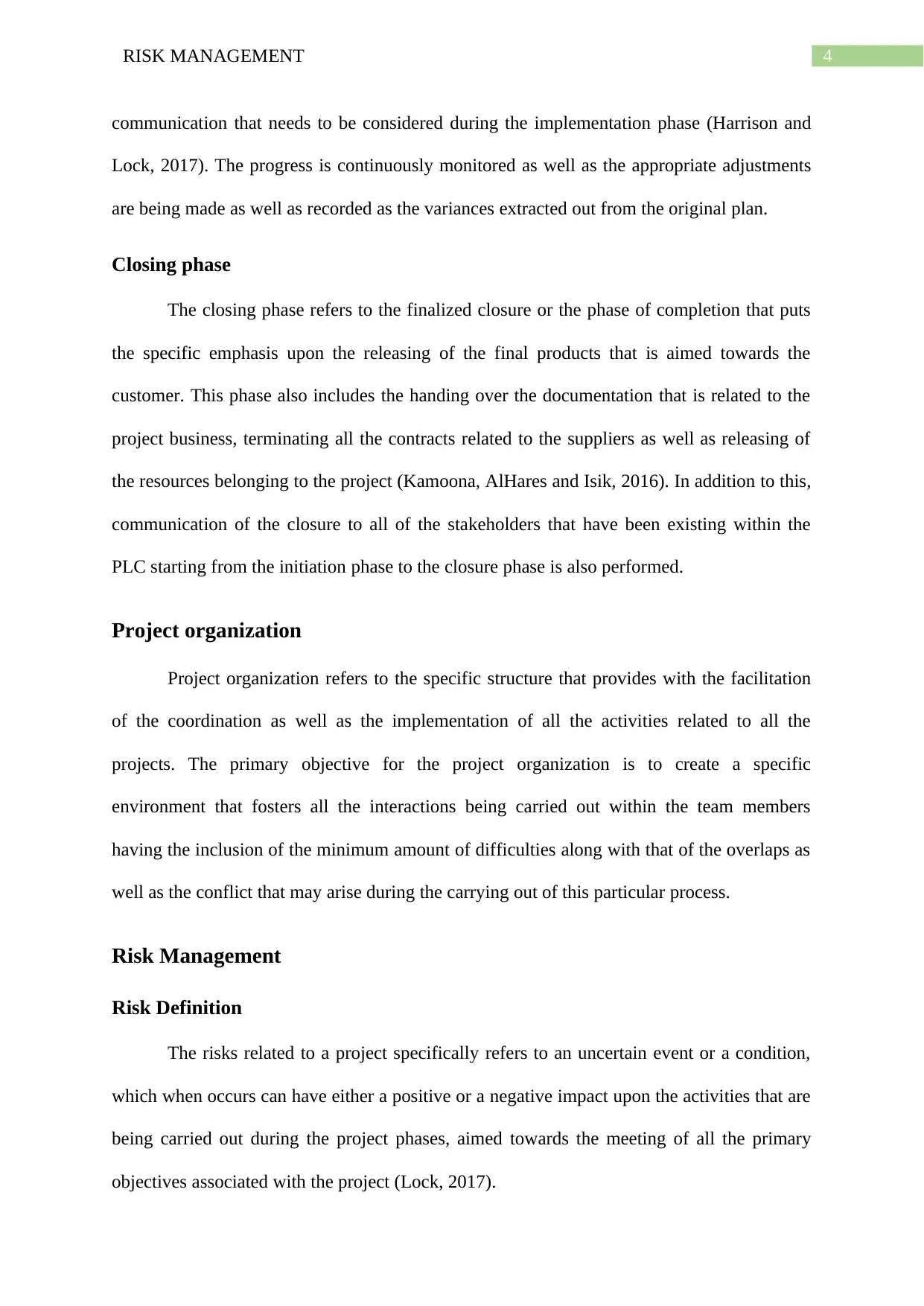
4RISK MANAGEMENT
communication that needs to be considered during the implementation phase (Harrison and
Lock, 2017). The progress is continuously monitored as well as the appropriate adjustments
are being made as well as recorded as the variances extracted out from the original plan.
Closing phase
The closing phase refers to the finalized closure or the phase of completion that puts
the specific emphasis upon the releasing of the final products that is aimed towards the
customer. This phase also includes the handing over the documentation that is related to the
project business, terminating all the contracts related to the suppliers as well as releasing of
the resources belonging to the project (Kamoona, AlHares and Isik, 2016). In addition to this,
communication of the closure to all of the stakeholders that have been existing within the
PLC starting from the initiation phase to the closure phase is also performed.
Project organization
Project organization refers to the specific structure that provides with the facilitation
of the coordination as well as the implementation of all the activities related to all the
projects. The primary objective for the project organization is to create a specific
environment that fosters all the interactions being carried out within the team members
having the inclusion of the minimum amount of difficulties along with that of the overlaps as
well as the conflict that may arise during the carrying out of this particular process.
Risk Management
Risk Definition
The risks related to a project specifically refers to an uncertain event or a condition,
which when occurs can have either a positive or a negative impact upon the activities that are
being carried out during the project phases, aimed towards the meeting of all the primary
objectives associated with the project (Lock, 2017).
communication that needs to be considered during the implementation phase (Harrison and
Lock, 2017). The progress is continuously monitored as well as the appropriate adjustments
are being made as well as recorded as the variances extracted out from the original plan.
Closing phase
The closing phase refers to the finalized closure or the phase of completion that puts
the specific emphasis upon the releasing of the final products that is aimed towards the
customer. This phase also includes the handing over the documentation that is related to the
project business, terminating all the contracts related to the suppliers as well as releasing of
the resources belonging to the project (Kamoona, AlHares and Isik, 2016). In addition to this,
communication of the closure to all of the stakeholders that have been existing within the
PLC starting from the initiation phase to the closure phase is also performed.
Project organization
Project organization refers to the specific structure that provides with the facilitation
of the coordination as well as the implementation of all the activities related to all the
projects. The primary objective for the project organization is to create a specific
environment that fosters all the interactions being carried out within the team members
having the inclusion of the minimum amount of difficulties along with that of the overlaps as
well as the conflict that may arise during the carrying out of this particular process.
Risk Management
Risk Definition
The risks related to a project specifically refers to an uncertain event or a condition,
which when occurs can have either a positive or a negative impact upon the activities that are
being carried out during the project phases, aimed towards the meeting of all the primary
objectives associated with the project (Lock, 2017).
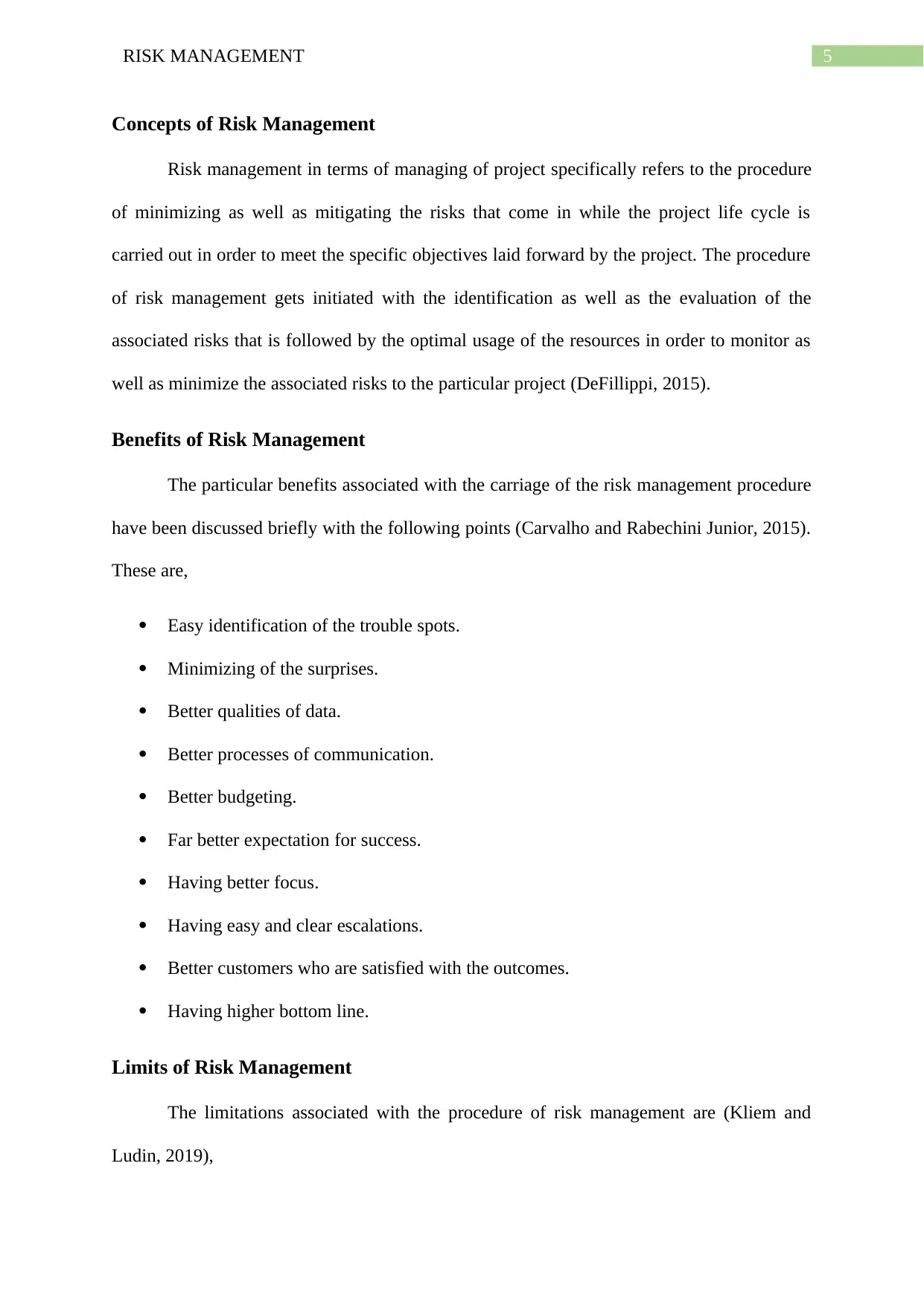
5RISK MANAGEMENT
Concepts of Risk Management
Risk management in terms of managing of project specifically refers to the procedure
of minimizing as well as mitigating the risks that come in while the project life cycle is
carried out in order to meet the specific objectives laid forward by the project. The procedure
of risk management gets initiated with the identification as well as the evaluation of the
associated risks that is followed by the optimal usage of the resources in order to monitor as
well as minimize the associated risks to the particular project (DeFillippi, 2015).
Benefits of Risk Management
The particular benefits associated with the carriage of the risk management procedure
have been discussed briefly with the following points (Carvalho and Rabechini Junior, 2015).
These are,
Easy identification of the trouble spots.
Minimizing of the surprises.
Better qualities of data.
Better processes of communication.
Better budgeting.
Far better expectation for success.
Having better focus.
Having easy and clear escalations.
Better customers who are satisfied with the outcomes.
Having higher bottom line.
Limits of Risk Management
The limitations associated with the procedure of risk management are (Kliem and
Ludin, 2019),
Concepts of Risk Management
Risk management in terms of managing of project specifically refers to the procedure
of minimizing as well as mitigating the risks that come in while the project life cycle is
carried out in order to meet the specific objectives laid forward by the project. The procedure
of risk management gets initiated with the identification as well as the evaluation of the
associated risks that is followed by the optimal usage of the resources in order to monitor as
well as minimize the associated risks to the particular project (DeFillippi, 2015).
Benefits of Risk Management
The particular benefits associated with the carriage of the risk management procedure
have been discussed briefly with the following points (Carvalho and Rabechini Junior, 2015).
These are,
Easy identification of the trouble spots.
Minimizing of the surprises.
Better qualities of data.
Better processes of communication.
Better budgeting.
Far better expectation for success.
Having better focus.
Having easy and clear escalations.
Better customers who are satisfied with the outcomes.
Having higher bottom line.
Limits of Risk Management
The limitations associated with the procedure of risk management are (Kliem and
Ludin, 2019),
⊘ This is a preview!⊘
Do you want full access?
Subscribe today to unlock all pages.

Trusted by 1+ million students worldwide
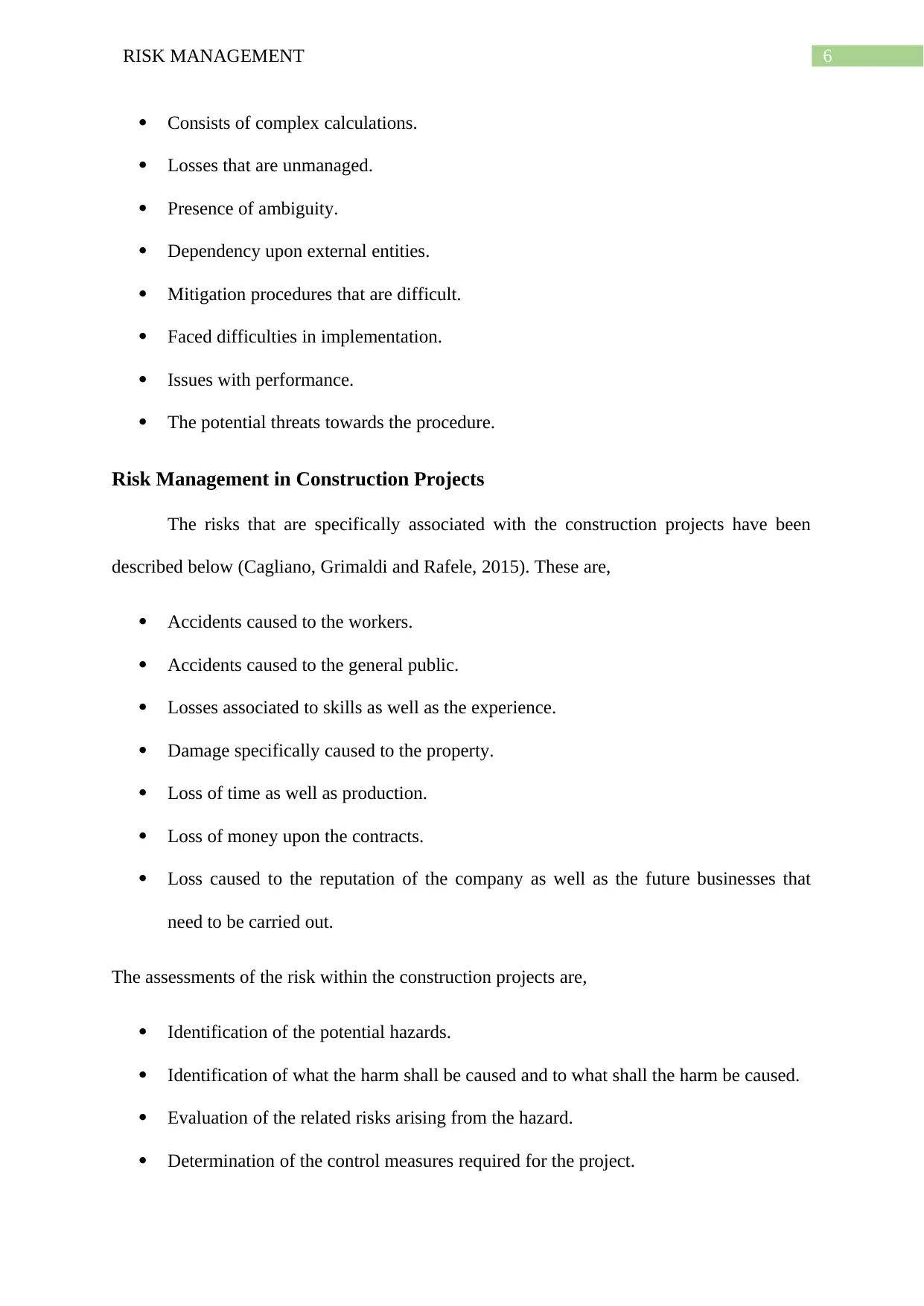
6RISK MANAGEMENT
Consists of complex calculations.
Losses that are unmanaged.
Presence of ambiguity.
Dependency upon external entities.
Mitigation procedures that are difficult.
Faced difficulties in implementation.
Issues with performance.
The potential threats towards the procedure.
Risk Management in Construction Projects
The risks that are specifically associated with the construction projects have been
described below (Cagliano, Grimaldi and Rafele, 2015). These are,
Accidents caused to the workers.
Accidents caused to the general public.
Losses associated to skills as well as the experience.
Damage specifically caused to the property.
Loss of time as well as production.
Loss of money upon the contracts.
Loss caused to the reputation of the company as well as the future businesses that
need to be carried out.
The assessments of the risk within the construction projects are,
Identification of the potential hazards.
Identification of what the harm shall be caused and to what shall the harm be caused.
Evaluation of the related risks arising from the hazard.
Determination of the control measures required for the project.
Consists of complex calculations.
Losses that are unmanaged.
Presence of ambiguity.
Dependency upon external entities.
Mitigation procedures that are difficult.
Faced difficulties in implementation.
Issues with performance.
The potential threats towards the procedure.
Risk Management in Construction Projects
The risks that are specifically associated with the construction projects have been
described below (Cagliano, Grimaldi and Rafele, 2015). These are,
Accidents caused to the workers.
Accidents caused to the general public.
Losses associated to skills as well as the experience.
Damage specifically caused to the property.
Loss of time as well as production.
Loss of money upon the contracts.
Loss caused to the reputation of the company as well as the future businesses that
need to be carried out.
The assessments of the risk within the construction projects are,
Identification of the potential hazards.
Identification of what the harm shall be caused and to what shall the harm be caused.
Evaluation of the related risks arising from the hazard.
Determination of the control measures required for the project.
Paraphrase This Document
Need a fresh take? Get an instant paraphrase of this document with our AI Paraphraser
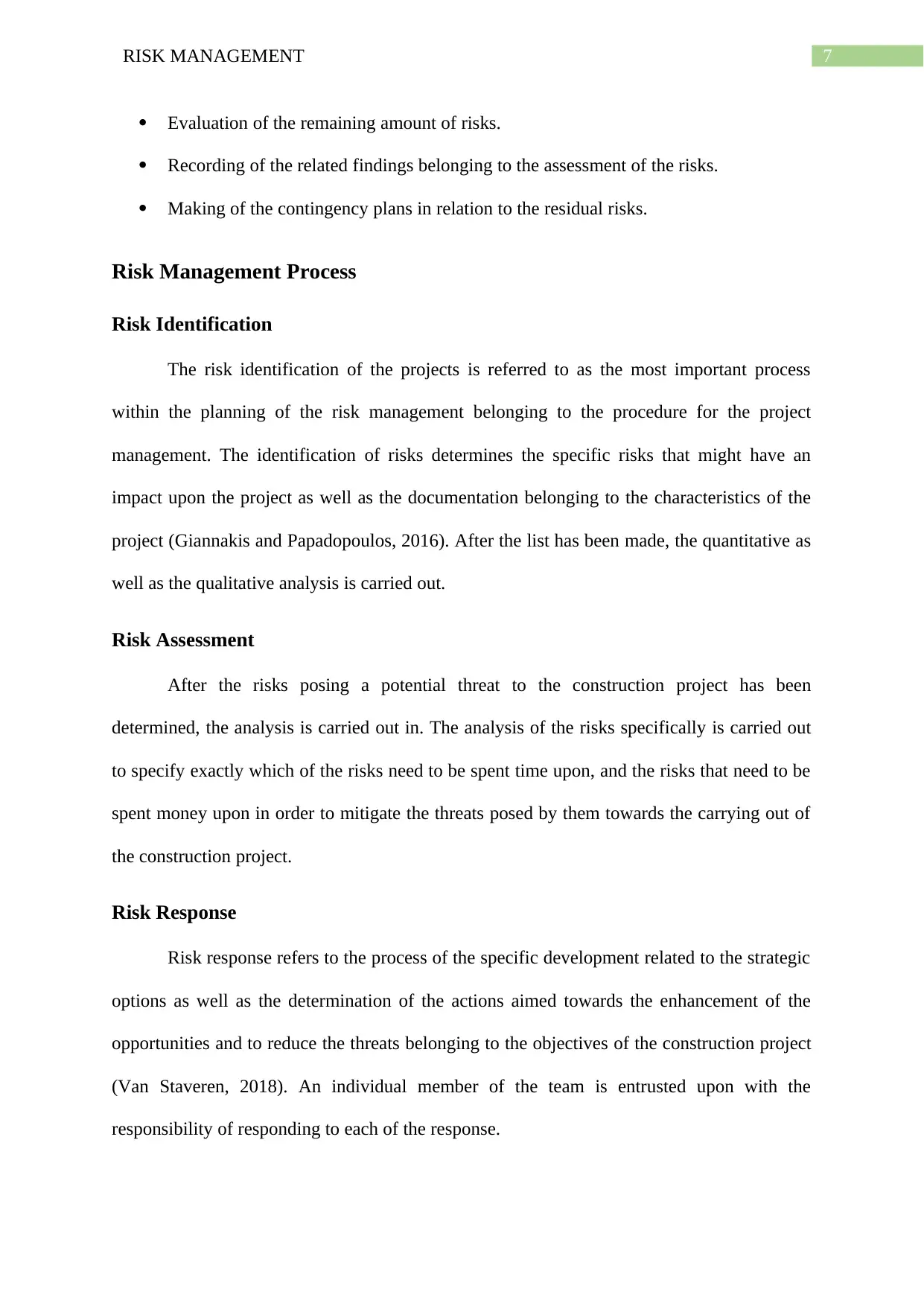
7RISK MANAGEMENT
Evaluation of the remaining amount of risks.
Recording of the related findings belonging to the assessment of the risks.
Making of the contingency plans in relation to the residual risks.
Risk Management Process
Risk Identification
The risk identification of the projects is referred to as the most important process
within the planning of the risk management belonging to the procedure for the project
management. The identification of risks determines the specific risks that might have an
impact upon the project as well as the documentation belonging to the characteristics of the
project (Giannakis and Papadopoulos, 2016). After the list has been made, the quantitative as
well as the qualitative analysis is carried out.
Risk Assessment
After the risks posing a potential threat to the construction project has been
determined, the analysis is carried out in. The analysis of the risks specifically is carried out
to specify exactly which of the risks need to be spent time upon, and the risks that need to be
spent money upon in order to mitigate the threats posed by them towards the carrying out of
the construction project.
Risk Response
Risk response refers to the process of the specific development related to the strategic
options as well as the determination of the actions aimed towards the enhancement of the
opportunities and to reduce the threats belonging to the objectives of the construction project
(Van Staveren, 2018). An individual member of the team is entrusted upon with the
responsibility of responding to each of the response.
Evaluation of the remaining amount of risks.
Recording of the related findings belonging to the assessment of the risks.
Making of the contingency plans in relation to the residual risks.
Risk Management Process
Risk Identification
The risk identification of the projects is referred to as the most important process
within the planning of the risk management belonging to the procedure for the project
management. The identification of risks determines the specific risks that might have an
impact upon the project as well as the documentation belonging to the characteristics of the
project (Giannakis and Papadopoulos, 2016). After the list has been made, the quantitative as
well as the qualitative analysis is carried out.
Risk Assessment
After the risks posing a potential threat to the construction project has been
determined, the analysis is carried out in. The analysis of the risks specifically is carried out
to specify exactly which of the risks need to be spent time upon, and the risks that need to be
spent money upon in order to mitigate the threats posed by them towards the carrying out of
the construction project.
Risk Response
Risk response refers to the process of the specific development related to the strategic
options as well as the determination of the actions aimed towards the enhancement of the
opportunities and to reduce the threats belonging to the objectives of the construction project
(Van Staveren, 2018). An individual member of the team is entrusted upon with the
responsibility of responding to each of the response.
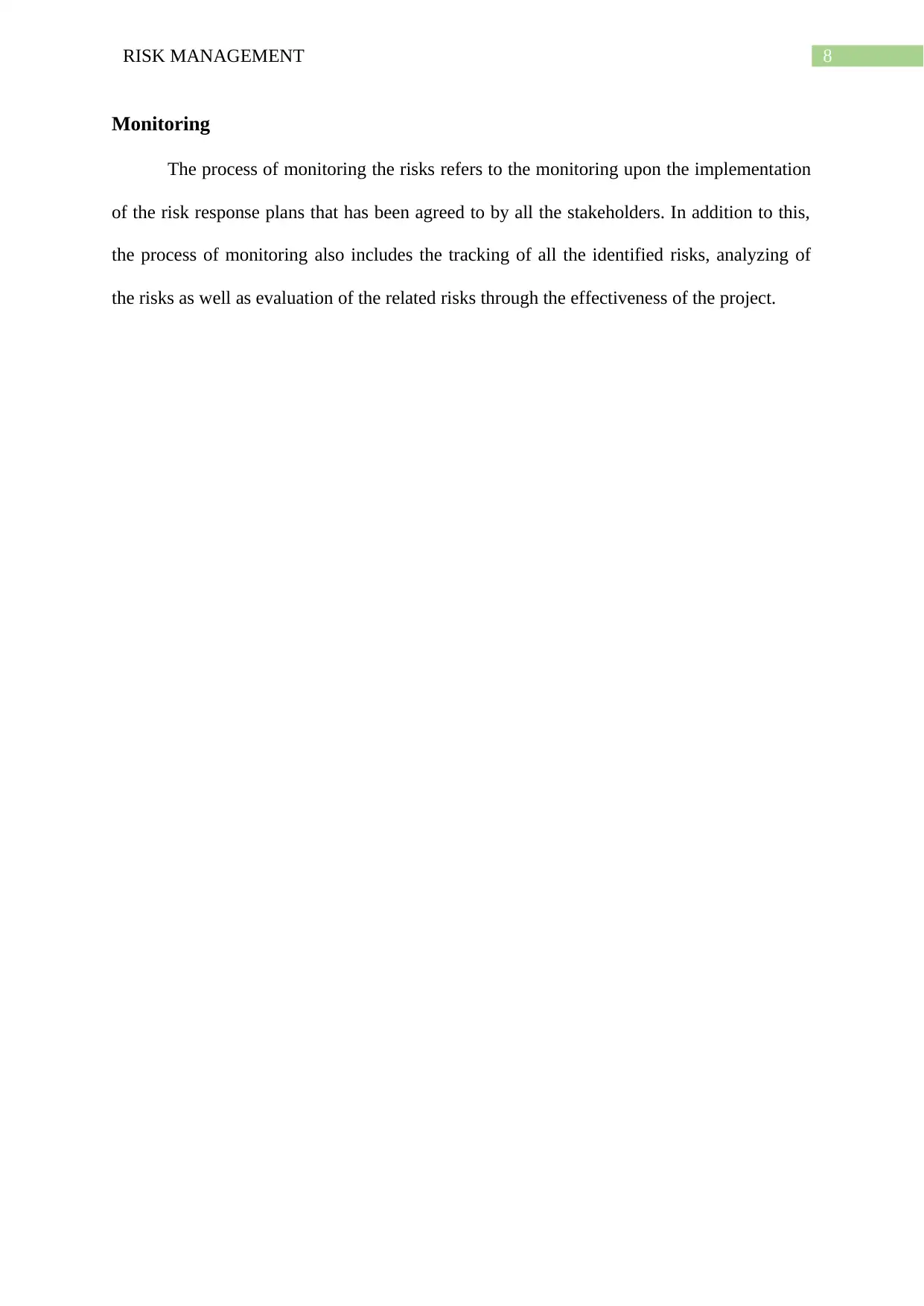
8RISK MANAGEMENT
Monitoring
The process of monitoring the risks refers to the monitoring upon the implementation
of the risk response plans that has been agreed to by all the stakeholders. In addition to this,
the process of monitoring also includes the tracking of all the identified risks, analyzing of
the risks as well as evaluation of the related risks through the effectiveness of the project.
Monitoring
The process of monitoring the risks refers to the monitoring upon the implementation
of the risk response plans that has been agreed to by all the stakeholders. In addition to this,
the process of monitoring also includes the tracking of all the identified risks, analyzing of
the risks as well as evaluation of the related risks through the effectiveness of the project.
⊘ This is a preview!⊘
Do you want full access?
Subscribe today to unlock all pages.

Trusted by 1+ million students worldwide
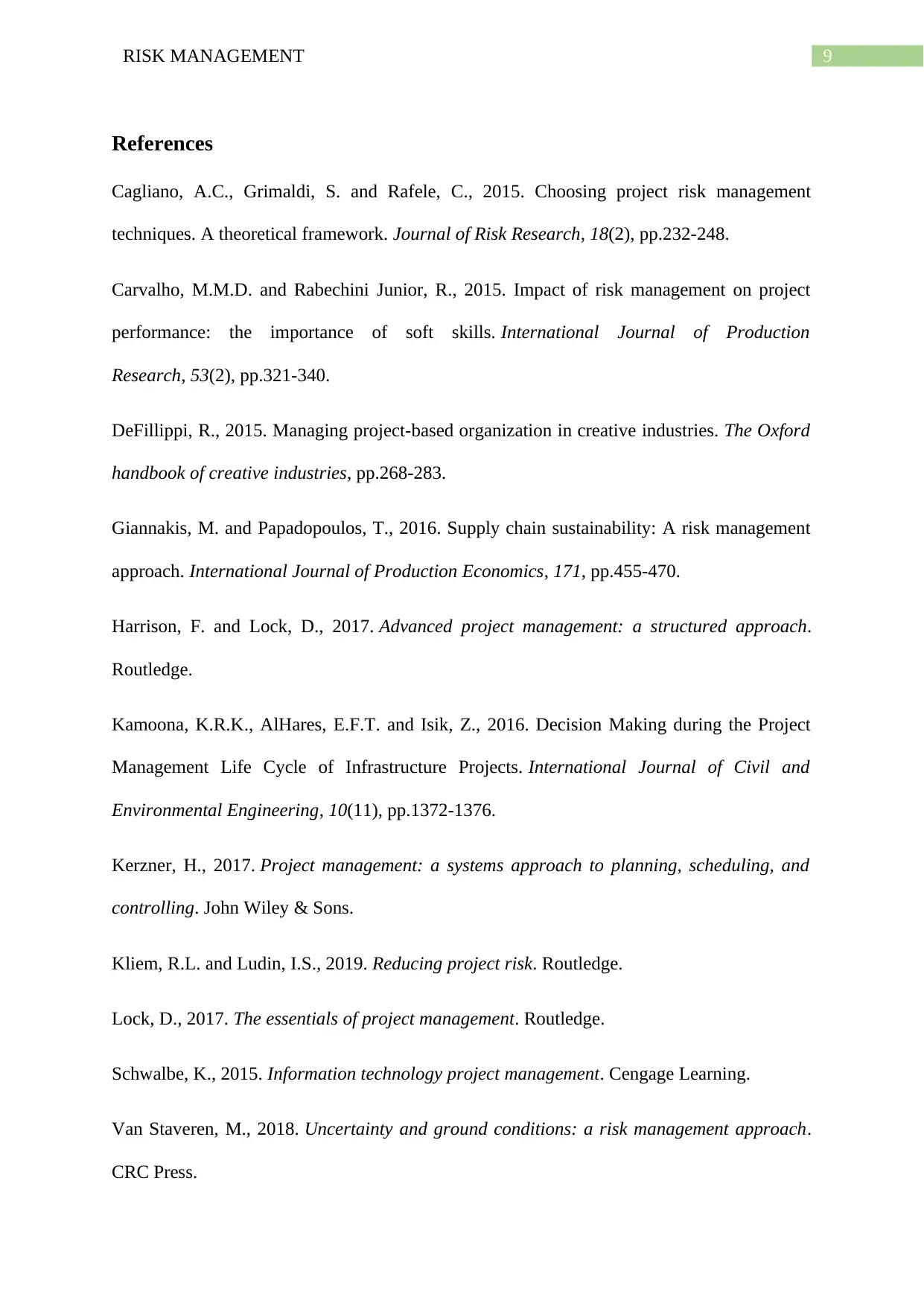
9RISK MANAGEMENT
References
Cagliano, A.C., Grimaldi, S. and Rafele, C., 2015. Choosing project risk management
techniques. A theoretical framework. Journal of Risk Research, 18(2), pp.232-248.
Carvalho, M.M.D. and Rabechini Junior, R., 2015. Impact of risk management on project
performance: the importance of soft skills. International Journal of Production
Research, 53(2), pp.321-340.
DeFillippi, R., 2015. Managing project-based organization in creative industries. The Oxford
handbook of creative industries, pp.268-283.
Giannakis, M. and Papadopoulos, T., 2016. Supply chain sustainability: A risk management
approach. International Journal of Production Economics, 171, pp.455-470.
Harrison, F. and Lock, D., 2017. Advanced project management: a structured approach.
Routledge.
Kamoona, K.R.K., AlHares, E.F.T. and Isik, Z., 2016. Decision Making during the Project
Management Life Cycle of Infrastructure Projects. International Journal of Civil and
Environmental Engineering, 10(11), pp.1372-1376.
Kerzner, H., 2017. Project management: a systems approach to planning, scheduling, and
controlling. John Wiley & Sons.
Kliem, R.L. and Ludin, I.S., 2019. Reducing project risk. Routledge.
Lock, D., 2017. The essentials of project management. Routledge.
Schwalbe, K., 2015. Information technology project management. Cengage Learning.
Van Staveren, M., 2018. Uncertainty and ground conditions: a risk management approach.
CRC Press.
References
Cagliano, A.C., Grimaldi, S. and Rafele, C., 2015. Choosing project risk management
techniques. A theoretical framework. Journal of Risk Research, 18(2), pp.232-248.
Carvalho, M.M.D. and Rabechini Junior, R., 2015. Impact of risk management on project
performance: the importance of soft skills. International Journal of Production
Research, 53(2), pp.321-340.
DeFillippi, R., 2015. Managing project-based organization in creative industries. The Oxford
handbook of creative industries, pp.268-283.
Giannakis, M. and Papadopoulos, T., 2016. Supply chain sustainability: A risk management
approach. International Journal of Production Economics, 171, pp.455-470.
Harrison, F. and Lock, D., 2017. Advanced project management: a structured approach.
Routledge.
Kamoona, K.R.K., AlHares, E.F.T. and Isik, Z., 2016. Decision Making during the Project
Management Life Cycle of Infrastructure Projects. International Journal of Civil and
Environmental Engineering, 10(11), pp.1372-1376.
Kerzner, H., 2017. Project management: a systems approach to planning, scheduling, and
controlling. John Wiley & Sons.
Kliem, R.L. and Ludin, I.S., 2019. Reducing project risk. Routledge.
Lock, D., 2017. The essentials of project management. Routledge.
Schwalbe, K., 2015. Information technology project management. Cengage Learning.
Van Staveren, M., 2018. Uncertainty and ground conditions: a risk management approach.
CRC Press.
Paraphrase This Document
Need a fresh take? Get an instant paraphrase of this document with our AI Paraphraser

10RISK MANAGEMENT
Volkov, A. and Kuzina, O., 2016. Complementary assets in the methodology of
implementation unified information model of the city environment project life
cycle. Procedia engineering, 153, pp.838-843.
Volkov, A. and Kuzina, O., 2016. Complementary assets in the methodology of
implementation unified information model of the city environment project life
cycle. Procedia engineering, 153, pp.838-843.
1 out of 11
Related Documents
Your All-in-One AI-Powered Toolkit for Academic Success.
+13062052269
info@desklib.com
Available 24*7 on WhatsApp / Email
![[object Object]](/_next/static/media/star-bottom.7253800d.svg)
Unlock your academic potential
Copyright © 2020–2025 A2Z Services. All Rights Reserved. Developed and managed by ZUCOL.





